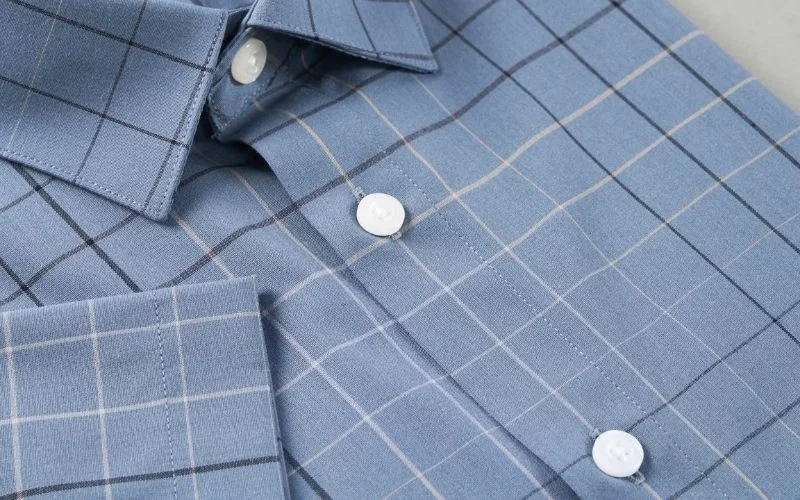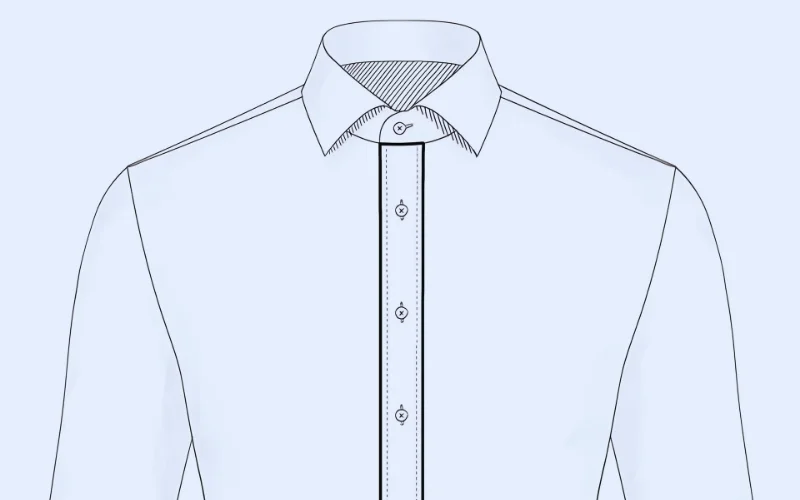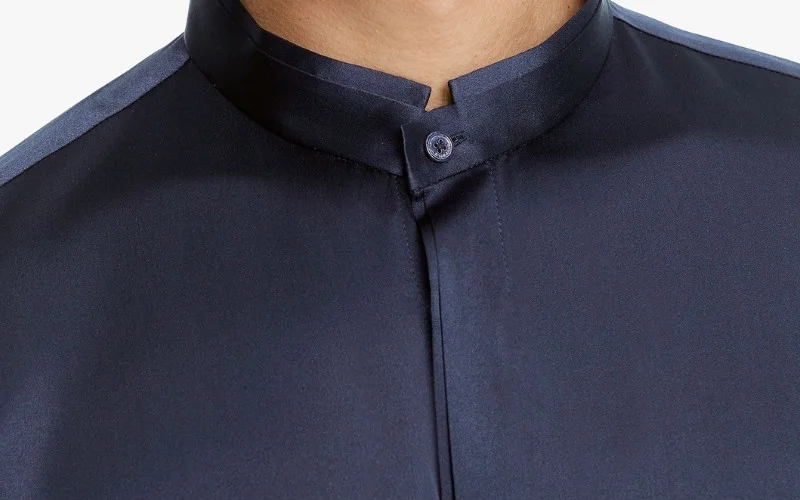Mastering Plackets: Types And Quality for Your Line
For clothing line owners and designers, mastering the details of garment construction is essential. One often-overlooked yet critical component is the placket. This article delves into the world of plackets, explaining what they are, exploring common variations like the standard shirt placket, French placket, and fly front, and highlighting key considerations in their design and production.
Understanding plackets—from fabric choices and the role of interfacing (a stiffening material sewn inside) to their impact on both function and style—will empower you to make informed decisions for your apparel, whether it’s a shirt, skirt, or pair of trousers. You’ll gain insights into selecting the right placket type to enhance your garments and align with your brand’s quality standards and aesthetic vision.
1. What exactly is a placket in garment making?
1.1. Defining the placket: Beyond a simple opening
In garment making, a placket refers to a finished, structural opening designed to make clothing easier to put on and take off, or to provide a point for closure. More than just a slit, a placket typically involves overlapping fabric layers that are reinforced to securely hold fasteners (like buttons, snaps, or zippers).
This finished opening is a common sewing technique found in various locations on apparel, including shirt fronts, sleeve cuffs, necklines, and the waistbands or seams of skirts and trousers. The construction ensures the opening is durable and neat.
1.2. The dual role: Functionality and aesthetics
Plackets serve two primary purposes in garment construction, blending practicality with visual appeal:
- Functionality: Their core function is practical. Plackets provide the necessary opening for easy dressing and undressing. They create a stable and reinforced area for attaching closure systems like buttons and buttonholes, snaps, or zippers, ensuring the garment closes securely. The extra layers of fabric also add strength to an area that experiences stress during wear.
- Aesthetics: Beyond utility, plackets contribute significantly to a garment’s overall style and finish. The type of placket chosen can define the look, ranging from classic (standard placket) to minimalist (French placket) or sleek (fly front). A well-executed placket provides a clean, professional finish and acts as a subtle or prominent design element, influencing the garment’s perceived quality and character.

2. Exploring common types of plackets for apparel
2.1. The standard shirt placket: A versatile classic
The standard placket is perhaps the most recognizable type, commonly seen on button-down shirts. It features a visible band of fabric stitched onto the garment’s front opening. This band is usually created from a separate piece of fabric, often reinforced with interfacing for structure, folded, and topstitched (visible stitching on the top surface) along its edges.
Buttonholes are typically placed vertically down this band. Its straightforward construction and classic appearance make this placket type suitable for a wide range of shirts, from casual wear to semi-formal styles.

2.2. The French placket: For a sleek, minimalist finish
Unlike the standard placket, the French placket achieves a cleaner, more minimalist look by eliminating the visible stitched band. Instead, the edge of the garment’s main fabric is simply folded back on itself (usually towards the inside) and stitched down to create the finished opening for buttons and buttonholes.
This folded fabric technique results in a smooth, uninterrupted front surface, lending a sleek appearance often favored for dress shirts, blouses, and garments aiming for a more refined or modern aesthetic.
2.3. The fly front placket: Concealing for clean lines
A fly front placket is designed to conceal the fasteners (buttons or a zipper) beneath an extra layer or flap of fabric. This construction creates a very clean, smooth line down the front of the garment, as the closure mechanism is hidden from view.
This type of placket is frequently used in formal shirts, such as tuxedo shirts, to maintain an elegant and uninterrupted appearance. It is also the standard closure for the fly on most trousers and many skirts, providing a neat and secure finish to the opening.
2.4. Polo shirt plackets: Adapting to knits and casual styles
Polo shirt plackets are distinct due to their typically shorter length, usually accommodating only two or three buttons, and their common use with knit fabrics. Constructing plackets in knits requires specific techniques for stabilization, often involving interfacing or special stitching, to prevent stretching and maintain shape.
This short placket style is inherently linked to casual wear and sportswear, contributing to the polo shirt’s characteristic look.

2.5. Essential openings: Plackets in skirts and trousers
Plackets are not exclusive to shirts and tops; they are essential components for bottoms as well. In skirts, plackets are often incorporated into side seams or center back seams, frequently utilizing zippers as the primary closure, sometimes accompanied by hooks-and-eyes at the waistband.
Similarly, the trouser placket, commonly known as the fly (usually a zipper fly), provides the necessary front opening. These waistband openings ensure skirts and trousers can be easily worn while maintaining a secure and neat closure system.
3. Key considerations in placket construction
3.1. Materials matter: Fabric, interfacing, and facings
The quality and performance of a placket depend heavily on the materials used:
- Main fabric: Typically, the placket is made from the same textile as the main body of the garment for visual consistency. The fabric’s weight and type influence how the placket will drape and behave.
- Interfacing: This is a crucial support material, often a non-woven or woven fabric fused or sewn between the fabric layers of the placket. Interfacing (or interlining) provides stability, prevents the placket area from stretching or collapsing (especially around buttonholes), adds structure and crispness, and supports the weight of fasteners. The choice of interfacing weight should complement the main fabric.
- Facings (sewing): Sometimes, a facing (a separate piece of fabric, often shaped, used to finish an edge) is used on the inside of the opening…
Understanding the interplay between these materials is key to achieving the desired garment structure and finish.

3.2. Why quality construction is non-negotiable for your brand
From a business perspective, the quality of placket construction directly impacts brand perception and customer satisfaction. Poorly made plackets—exhibiting issues like puckering seams, uneven edges, weak button attachments, improper interfacing causing bubbling or stiffness, or mismatched patterns—signal low overall quality and diminish the garment’s perceived value.
Such flaws not only affect the aesthetic appeal but also compromise durability, leading to potential customer complaints and returns. Conversely, a well-executed placket with precise stitching, appropriate reinforcement, and a clean finish enhances the garment’s look, feel, and longevity.
Investing in quality sewing techniques for details like plackets demonstrates attention to detail and builds trustworthiness, reinforcing a positive brand image in apparel manufacturing.
4. Selecting the ideal placket for your garments
4.1. Matching the placket to your design vision and garment style
Choosing the right placket is an integral design decision that should align with the overall aesthetic and intended formality of the garment. Consider the message you want the clothing design to convey:
- A standard placket offers a classic, reliable look suitable for everyday shirts and casual wear.
- A French placket provides a minimalist, refined finish, ideal for elegant blouses, modern dress shirts, or garments where clean lines are paramount.
- A fly front placket lends sleekness and formality, perfect for tuxedo shirts, tailored trousers, skirts, or outerwear where hidden closures enhance the design.
- A polo placket inherently signals sportswear or casual style variations.
Thinking about the placket as a key design element, rather than just a functional necessity, allows you to purposefully shape the garment’s style.
4.2. Practical factors: Fabric compatibility and production implications
Beyond aesthetics, practical considerations are crucial for small businesses. The chosen fabric choice significantly impacts placket construction; lightweight or unstable fabrics require more substantial interfacing and careful handling to prevent distortion, while very bulky fabrics might make certain placket types difficult to execute neatly. Furthermore, the complexity of the placket type directly affects apparel manufacturing:
- A French placket is relatively simple in terms of sewing steps.
- A standard placket involves attaching a separate piece, adding steps.
- A fly front placket, especially with a zipper, is considerably more complex, requiring higher sewing skill and more time.
These factors influence production cost and the tailoring basics required within your manufacturing setup. Assess whether the added complexity and cost align with the garment’s price point and production capabilities.

4.3. Aligning with customer expectations
Consider your target audience and their likely style preferences and expectations for the specific garment type and price point. Are they seeking rugged durability in workwear, where a sturdy standard placket might be preferred?
Or are they looking for refined details in a fashion piece, where the clean lines of a French or fly front placket offer higher perceived value? Matching the placket choice to these underlying customer expectations ensures the detail resonates positively and contributes to the garment’s overall appeal and market positioning, enhancing long-term value.
5. Related questions
5.1. What’s the difference between a placket and a facing?
While both are used in garment finishing, a placket and a facing serve different primary functions according to standard sewing terminology. A placket is specifically a finished opening in a garment, usually incorporating overlapping layers and designed to facilitate dressing or closure with fasteners.
Common examples are shirt front openings or sleeve cuff openings. A facing, on the other hand, is a piece of fabric (often shaped to match) sewn to a raw edge (like a neckline, armhole, or hem) and turned to the inside to provide a clean finish.
While some placket constructions might incorporate facing techniques to finish internal edges, the core distinction is that a placket is the opening structure itself, whereas a facing finishes an edge. They are distinct garment parts, though sometimes used together.
5.2. Can any fabric be used for a placket?
Technically, a placket can be constructed from almost any material, but the suitability varies significantly based on fabric properties. The main consideration is achieving the necessary structure and stability.
- Fabric weight: Very lightweight fabrics will likely require substantial interfacing to prevent collapsing or stretching, especially around buttonholes. Very heavy or bulky fabrics can make the overlapping layers thick and difficult to sew neatly, potentially creating unwanted bulk.
- Stability: Stretchy knit fabrics require careful handling and appropriate interfacing choices (often stretch or fusible knit interfacing) to maintain shape without restricting the fabric’s natural movement too much. Stable woven fabrics are generally easier to work with for plackets.
- Aesthetics: The fabric choice also impacts the final look. Textured or patterned fabrics need careful alignment if using a separate placket piece.
While the placket usually matches the garment fabric, successful construction always depends on choosing the right interfacing and techniques for that specific material.
5.3. How does interfacing strengthen a placket?
Interfacing plays a critical functional role in strengthening a placket by providing several benefits:
- Support and body: It adds substance to the fabric layers, helping the placket maintain its shape and preventing it from looking limp or collapsing.
- Stability: Interfacing prevents the fabric around buttonholes and buttons from stretching or distorting under stress, ensuring the closure remains secure and neat over time. This buttonhole stability is crucial for durability.
- Structure: It helps create a flat, crisp finish, particularly along the edges of standard or fly front plackets, contributing to a professional appearance.
- Reinforcement: It supports the weight and strain of the fasteners themselves.
Different weights and types of interfacing offer varying degrees of stiffness and support, allowing for customization based on the main fabric and desired garment structure.
Read more:
Understanding plackets—recognizing they are more than simple openings and appreciating the nuances between types like standard, French, and fly front—is fundamental for any apparel business aiming for quality and style consistency.
The choice of placket, the materials used (especially fabric and interfacing), and the quality of construction significantly influence a garment’s functionality, aesthetic appeal, durability, and ultimately, customer perception.
Making informed decisions about plackets allows you to elevate your clothing design, align details with your brand identity, and manage production effectively. Applying this knowledge thoughtfully will contribute to the overall success and perceived value of your products.
For tailored advice on complementary elements like custom labels, tags, or packaging that reflect your garment quality, explore the resources at Packlove.






















